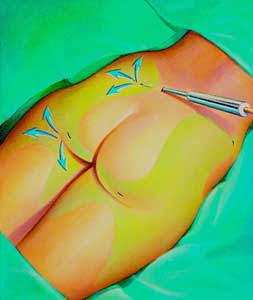| Liposuction: Understanding All Those Confusing Techniques
"Help me doctor! I keep hearing about all these new and improved liposuction techniques. What does it all mean, and which ones really work?" As a Los Angeles plastic surgeon, I regularly hear these questions from people interested in plastic surgery. All the claims and counter claims make it very difficult for people to understand the truth. It is important to provide clarity on each of these Beverly Hills liposuction techniques and technologies. 
Liposuction, also known as Suction Assisted Lipectomy (SAL), is the term used to describe the basic surgical procedure of removing fat cells from the space under the skin. It is done with a hollow metal tube, called a cannula, which is attached to a suction machine.
The Dry Technique is the original method of conducting liposuction. A small incision is made into the skin and the hollow tube is inserted into the area where excess fat will be removed. No other fluid or medicine is placed into the area and this technique is associated with a higher degree of blood loss, which leads to more swelling, bruising and overall risk. In general, except in rare special circumstances, this type of liposuction is no longer performed.
Tumescent Liposuction, is the most preferred technique today. TheBeverly Hills, plastic surgeon first places a large volume of saline, usually mixed with a pain killer (Lidocain, which is sometimes inaccurately referred to by the public as Novocain) and a medication that decreases bleeding (dilute Epinephrine) to the area where the procedure is being performed. Several advantages to this technique include diminished postoperative pain, decreased bleeding and bruising and a better aesthetic result. It is believed that the improved cosmetic results are due to the firmness created by the added fluid, which allows the surgeon to actually sculpt the area to the desired shape. This method is still considered the gold standard for liposuction
Ultrasound-Assisted Liposuction (UAL) is liposuction that adds an ultrasound wave-producing device into the fat. The theory is that the sound waves will dislodge fat cells from their attachment to thicker collagen fibers. This technique may be useful in areas of the body where there are many of these thick fibers, such as the upper abdomen, back and where scar tissue exists. The downside of UAL is that the device has been known to cause skin burns, leave increased wavy irregularities of the skin and may be associated with additional blood loss.
Power-Assisted Liposuction is when a small motor is attached to the cannula to move it in and out. The major advantage to this technique is to the surgeon, who experiences less fatigue, and not to the patient. This technique offers no improvement to the final results.
Laser-Assisted Liposuction adds laser technology to the standard liposuction procedure. It is a two-step method, where, first a thin glass fiber is inserted into the area and the fat is melted in small volumes by the laser energy. The second step requires a standard form of liposuction to remove the liquefied fat and any additional fat cells. This technique is still relatively new, and it is unclear whether the laser truly adds any benefit to the final results. Thus far, reputable studies have shown no major clinical benefit.
External Devices such as external ultrasound and skin vacuum rollers or cellulite massage devices have not been shown to have any benefit in eliminating fat from under the skin. Despite various claims to the contrary, they are not alternatives to liposuction.
Injection techniques such as Mesotherapy, injection lipolysis or Lipodissolve claim to be non-surgical alternatives to liposuction. These techniques involve the injection of fat-dissolving chemicals that are supposed to dissolve fat cells. This technique has many unknowns and the results are uncertain, difficult to control and unpredictable. Allergic reaction, skin ulcers, scarring and infections have been known to occur.
The Future holds many possibilities for advances in Beverly Hills liposuction techniques. The Power Water-Assisted liposuction and improved laser technology may offer viable future improvements in the current methodology for SAL. Only with critical scientific analysis will we know if they offer true clinical advantages.
For questions regarding liposuction, plastic surgery or skin care, contact Dr. Warren Lent, MD, FACS, at 310.652.6500, via email at drlent@mybestplasticsurgeon.com or visit www.mybestplasticsurgeon.com.
|
